Mechanical Behavior of Coupled Elastoplastic Damage of Clastic Sandstone of Different Burial Depths
Abstract
1. Introduction
2. Triaxial Compression Test of Different Burial Depths of Clastic Sandstone
2.1. Experimental Material and Procedure
2.2. Mechanical Behavior of Triaxial Compression Tests
2.3. Behavior of Volumetric Strain
2.4. Damage Evolution during Triaxial Compression Tests
3. Elastoplastic Damage Coupling Model
3.1. Framework of Elastoplastic Damage Coupling Model
3.2. Formulation of Elastoplastic Damage Coupling Model
3.3. Verification of Elastoplastic Damage Coupling Model
4. Conclusions
- The clastic sandstone exhibited an evident pressure-dependent behavior. The entire deformation process of the samples consists of elastic, yield, plastic hardening and damage softening stages. The samples displayed evident volumetric compressibility changes to dilatancy in the tests. It is closely related to the evolution of internal damage which is induced by the propagation and coalescence of the micro-defects.
- The mechanical response of samples is affected by plastic deformation and damage. A damage variable is used to quantitatively describe the degradation of the rock; the damage evolution of clastic sandstone samples under different confining pressures can be divided into three stages. Thus, an elastoplastic damage coupling model was proposed. This model describes the main properties of clastic sandstone, such as elastoplastic behavior, the coupling between plastic flow and damage and volume transformation, from compression to dilation.
- Increasing burial depth and confining pressure can improve the load-bearing capacity and resistance to deformation of the sample. The peak stress and elastic modulus show an increasing trend with increasing confining pressure and burial depth due to the closure of the internal micro-defects in the sample. In addition, the increase in confining pressure and burial depth effectively limits the volumetric dilation strain and decreases the maximum volume of compressive strain.
Author Contributions
Funding
Conflicts of Interest
References
- Zhao, Z.; Du, J.; Zou, C.; Hu, S. Geological exploration theory for large oil and gas provinces and its significance. Pet. Explor. Dev. 2011, 38, 513–522. [Google Scholar] [CrossRef]
- El-Din, E.S.; Mesbah, M.A.; Kassab, M.A.; Mohamed, I.F.; Cheadle, B.A.; Teama, M.A. Assessment of petrophysical parameters of clastics using well logs: The Upper Miocene in El-Wastani gas field, onshore Nile Delta, Egypt. Pet. Explor. Dev. 2013, 40, 488–494. [Google Scholar] [CrossRef]
- Sun, L.; Fang, C.; Sa, L.; Yang, P.; Sun, Z. Innovation and prospect of geophysical technology in the exploration of deep oil and gas. Pet. Explor. Dev. 2015, 42, 454–465. [Google Scholar] [CrossRef]
- Li, M.; Wu, G.; Xia, B.; Huang, T.; Ni, B.; Pang, S.; Long, X. Controls on hydrocarbon accumulation in clastic reservoirs of the Tarim Craton, NW China. Mar. Pet. Geol. 2019, 104, 423–437. [Google Scholar] [CrossRef]
- Monsees, A.C.; Busch, B.; Schöner, N.; Hilgers, C. Rock typing of diagenetically induced heterogeneities—A case study from a deeply-buried clastic Rotliegend reservoir of the Northern German Basin. Mar. Pet. Geol. 2020, 113, 104163. [Google Scholar] [CrossRef]
- Virolle, M.; Brigaud, B.; Luby, S.; Portier, E.; Féniès, H.; Bourillot, R.; Patrier, P.; Beaufort, D. Influence of sedimentation and detrital clay grain coats on chloritized sandstone reservoir qualities: Insights from comparisons between ancient tidal heterolithic sandstones and a modern estuarine system. Mar. Pet. Geol. 2019, 107, 163–184. [Google Scholar] [CrossRef]
- Yang, T.; Cao, Y.; Wang, Y.; Liu, K.; He, C.; Zhang, S. Determining permeability cut-off values for net pay study of a low-permeability clastic reservoir: A case study of the Dongying Sag, eastern China. J. Pet. Sci. Eng. 2019, 178, 262–271. [Google Scholar] [CrossRef]
- Yuan, W. Water-sensitive characterization and its controlling factors in clastic reservoir: A case study of Jurassic the Formation in Northern tectonic zone of Kuqa depression. Pet. Res. 2019, 5, 77–82. [Google Scholar] [CrossRef]
- Salari, M.R.; Saeb, S.; Willam, K.J.; Patchet, S.J.; Carrasco, R.C. A coupled elastoplastic damage model for geomaterials. Comput. Methods Appl. Mech. Eng. 2004, 193, 2625–2643. [Google Scholar] [CrossRef]
- Zhou, J.; Xu, W.; Yang, X. A microcrack damage model for brittle rocks under uniaxial compression. Mech. Res. Commun. 2010, 37, 399–405. [Google Scholar] [CrossRef]
- Shojaei, A.; Taleghani, A.D.; Li, G. A continuum damage failure model for hydraulic fracturing of porous rocks. Int. J. Plast. 2014, 59, 199–212. [Google Scholar] [CrossRef]
- Zhang, Y.; Liu, Z.; Xu, W.; Shao, J. Change in the permeability of clastic rock during multi-loading triaxial compressive creep tests. Geotech. Lett. 2015, 5, 167–172. [Google Scholar] [CrossRef]
- Ma, J.; Zhao, G.; Khalili, N. An elastoplastic damage model for fractured porous media. Mech. Mater. 2016, 100, 41–54. [Google Scholar] [CrossRef]
- Shen, W.; Shao, J. Some micromechanical models of elastoplastic behaviors of porous geomaterials. J. Rock. Mech. Geotech. Eng. 2017, 9, 1–17. [Google Scholar] [CrossRef]
- Zhu, Y. A micromechanics-based damage constitutive model of porous rocks. Int. J. Rock Mech. Min. Sci. 2017, 91, 1–6. [Google Scholar] [CrossRef]
- Bennett, K.C.; Borja, R.I. Hyper-elastoplastic/damage modeling of rock with application to porous limestone. Int. J. Solids Struct. 2018, 143, 218–231. [Google Scholar] [CrossRef]
- Jiang, X.; Wan, L.; Wang, X.; Liang, S.; Hu, B. Estimation of fracture normal stiffness using a transmissivity-depth correlation. Int. J. Rock Mech. Min. Sci. 2009, 46, 51–58. [Google Scholar] [CrossRef]
- Øyvind, M.; Maast, T.E.; Mondol, N.H.; Jahren, J.; Bjørlykke, K. Changes in physical properties of a reservoir sandstone as a function of burial depth-The Etive Formation, northern North Sea. Mar. Pet. Geol. 2010, 27, 1725–1735. [Google Scholar]
- Aschwanden, L.; Diamond, L.W.; Adams, A. Effects of progressive burial on matrix porosity and permeability of dolostones in the foreland basin of the Alpine Orogen, Switzerland. Mar. Pet. Geol. 2019, 100, 148–164. [Google Scholar] [CrossRef]
- Peng, K.; Liu, Z.; Zou, Q.; Wu, Q.; Zhou, J. Mechanical property of granite from different buried depths under uniaxial compression and dynamic impact: An energy-based investigation. Powder Technol. 2020, 362, 729–744. [Google Scholar] [CrossRef]
- Jiang, G.; Zuo, J.; Li, Y.; Wei, X. Experimental investigation on mechanical and acoustic parameters of different depth shale under the effect of confining pressure. Rock Mech. Rock Eng. 2019, 52, 4273–4286. [Google Scholar] [CrossRef]
- Peng, K.; Liu, Z.; Zou, Q.; Zhang, Z.; Zhou, J. Static and dynamic mechanical properties of granite from various burial depths. Rock Mech. Rock Eng. 2019, 52, 3545–3566. [Google Scholar]
- Zhang, Y.; Shao, J.; Xu, W.; Zhao, H.; Wang, W. Experimental and numerical investigations on strength and deformation behavior of cataclastic sandstone. Rock Mech. Rock Eng. 2015, 48, 1083–1096. [Google Scholar] [CrossRef]
- Zhang, Y.; Shao, J.; Xu, W.; Jia, Y. Time-dependent behavior of cataclastic rocks in a multi-loading triaxial creep test. Rock Mech. Rock Eng. 2016, 49, 3793–3803. [Google Scholar] [CrossRef]
- Mohamad-Hussein, A.; Shao, J. Modelling of elastoplastic behavior with non-local damage in concrete under compression. Comput. Struct. 2007, 85, 1757–1768. [Google Scholar] [CrossRef]
- Liu, L.; Xu, W.; Zhao, L.; Zhu, Q.; Wang, R. An experimental and numerical investigation of the mechanical behavior of granite gneiss under compression. Rock Mech. Rock Eng. 2017, 50, 499–506. [Google Scholar] [CrossRef]
- Chen, L.; Shao, J.; Huang, H. Coupled elastoplastic damage modeling of anisotropic rocks. Comput. Geotech. 2010, 37, 187–194. [Google Scholar] [CrossRef]
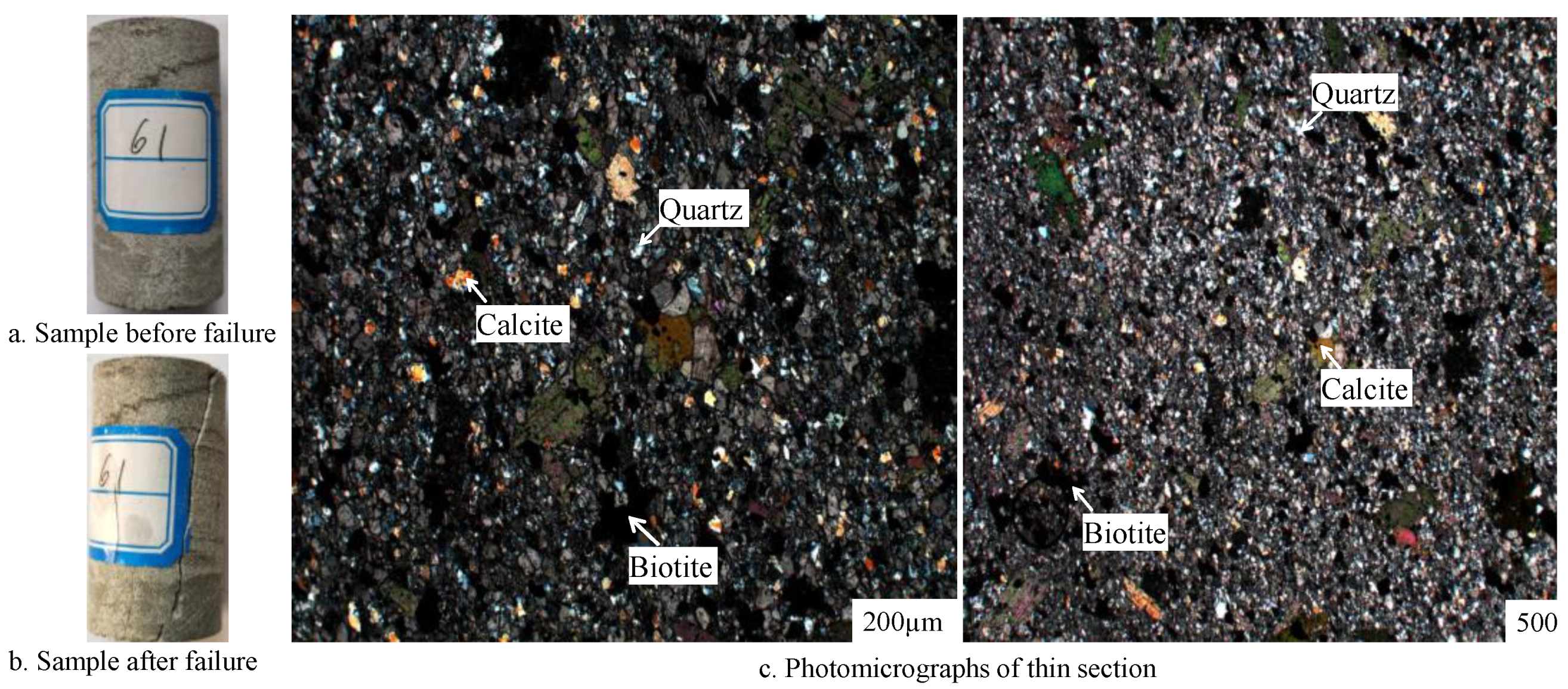
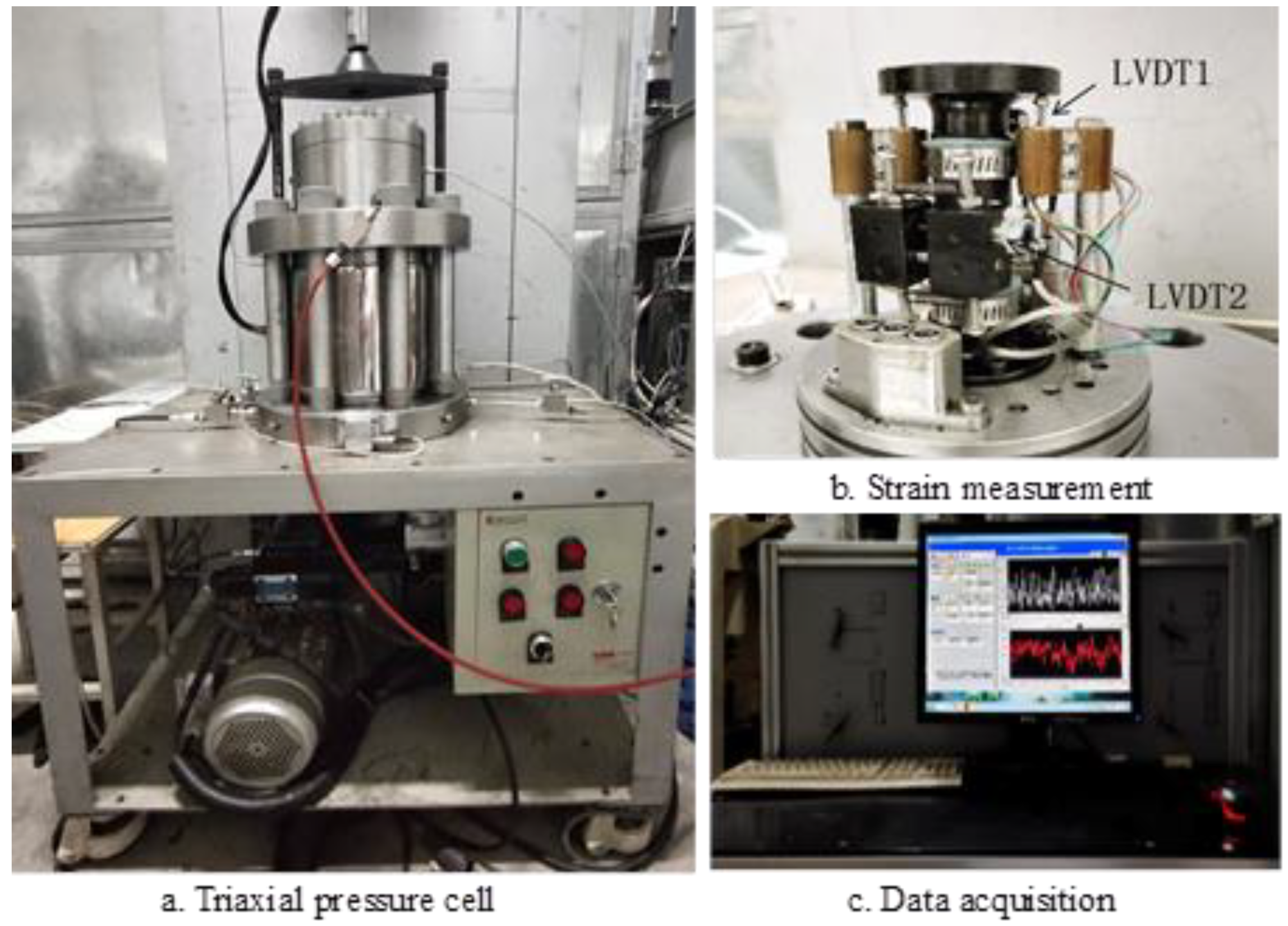
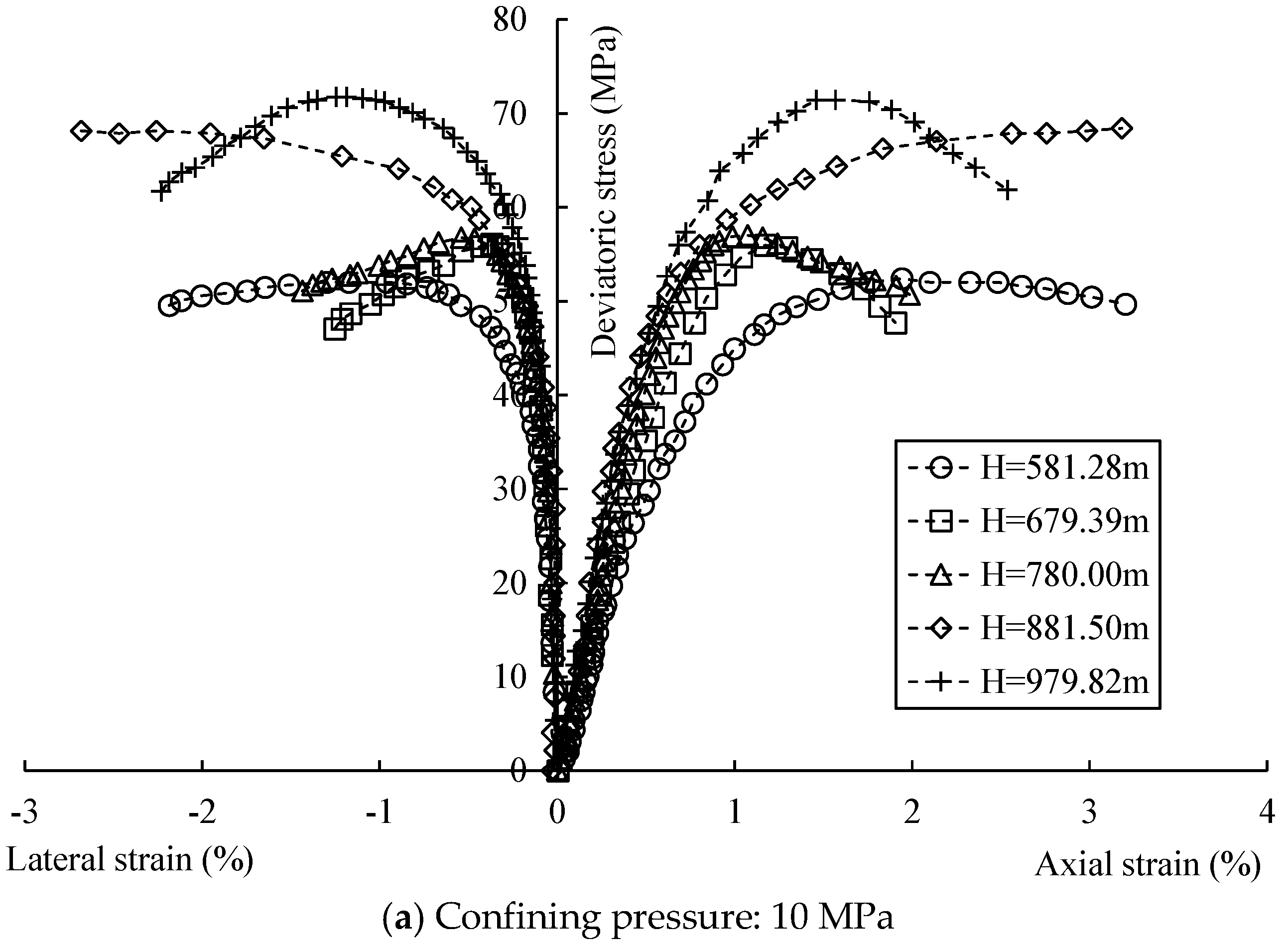
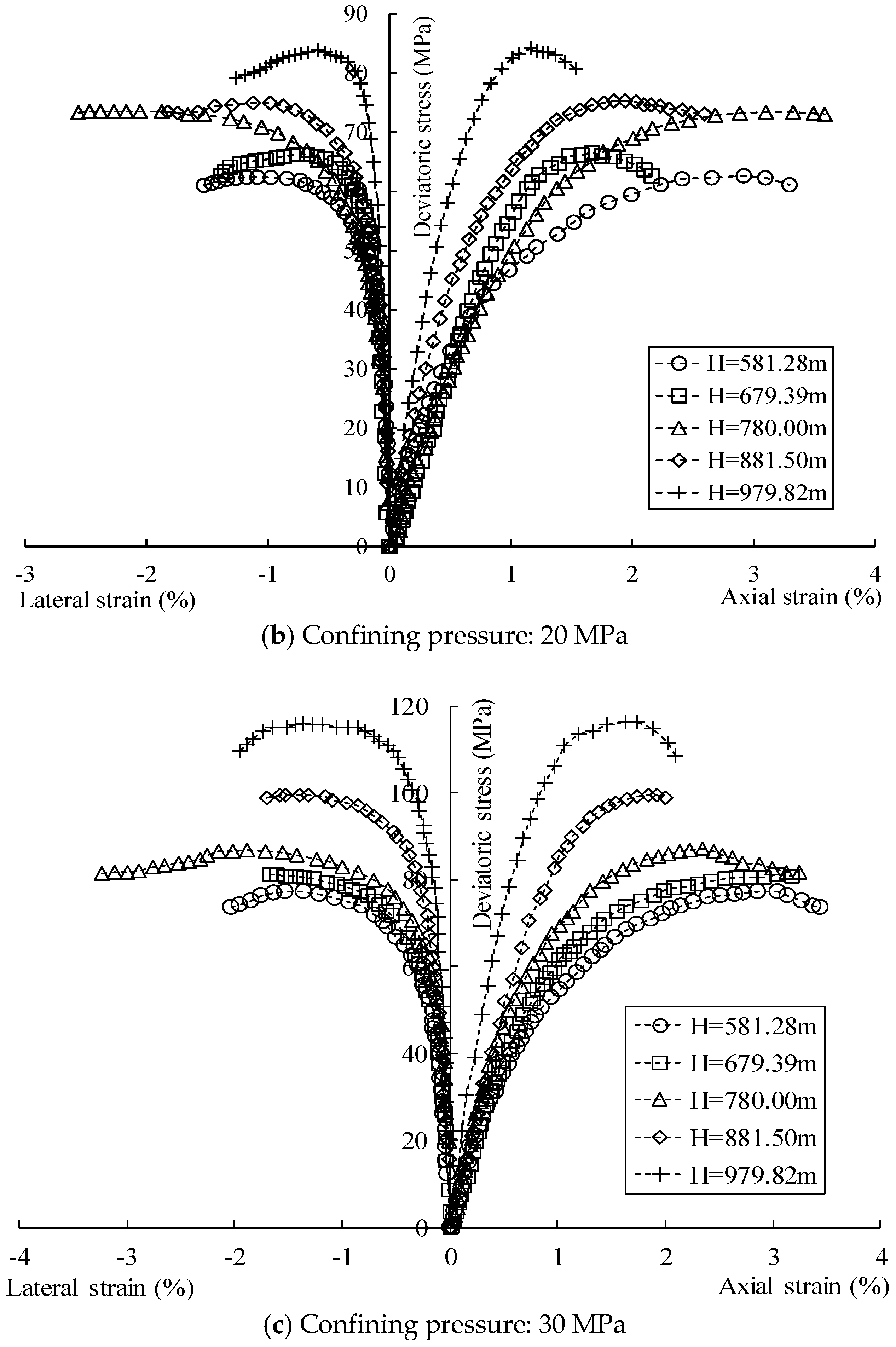

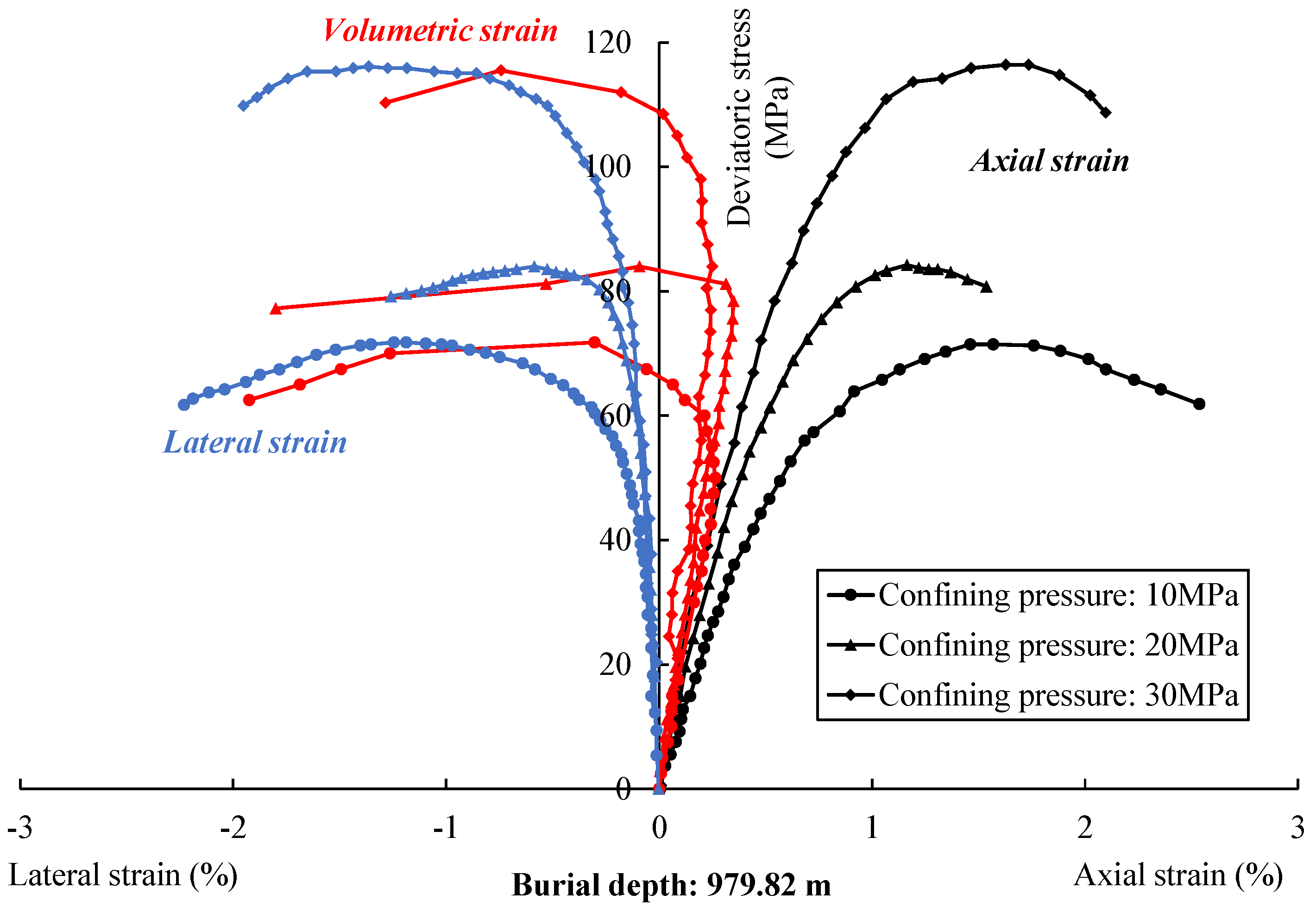
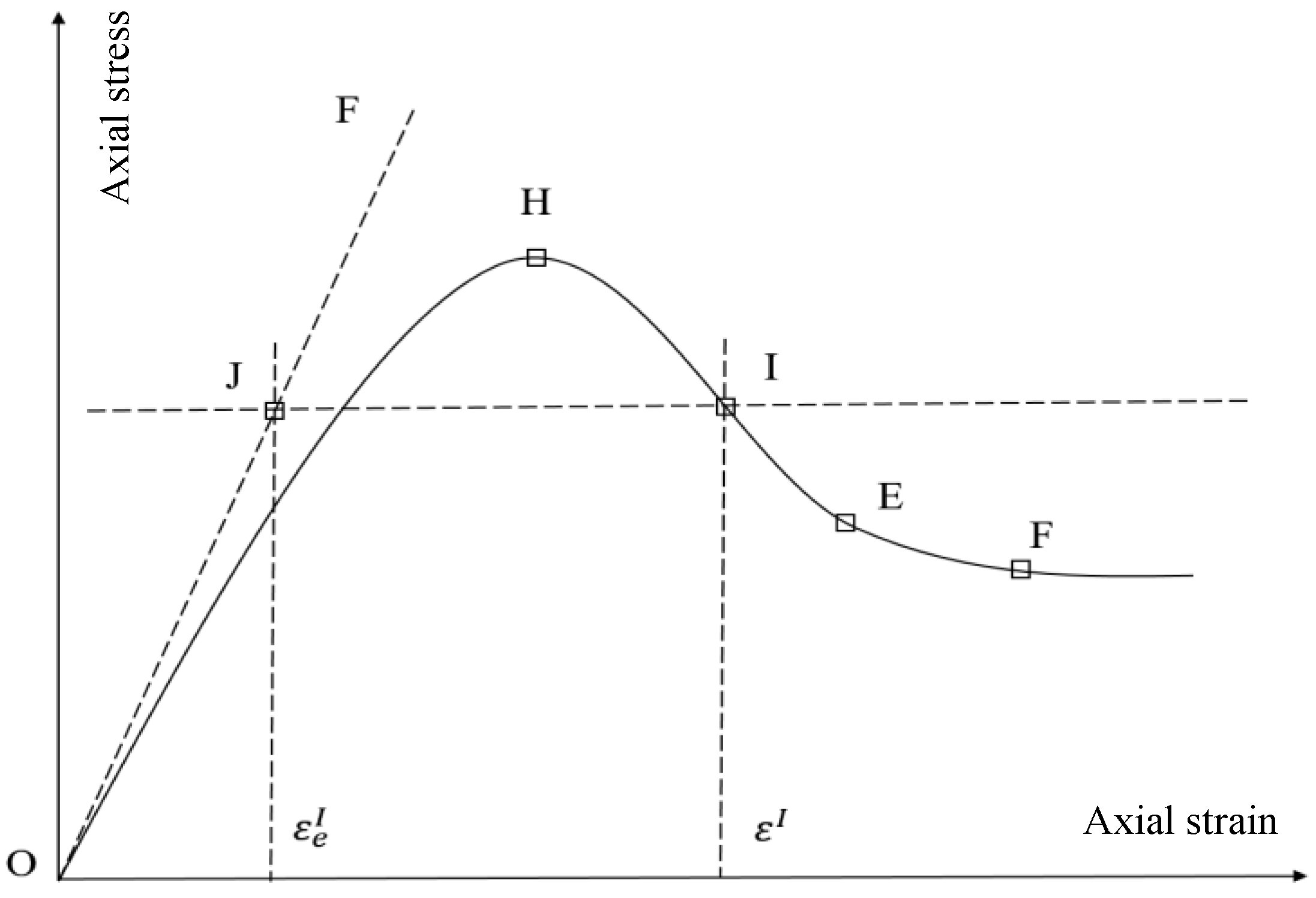
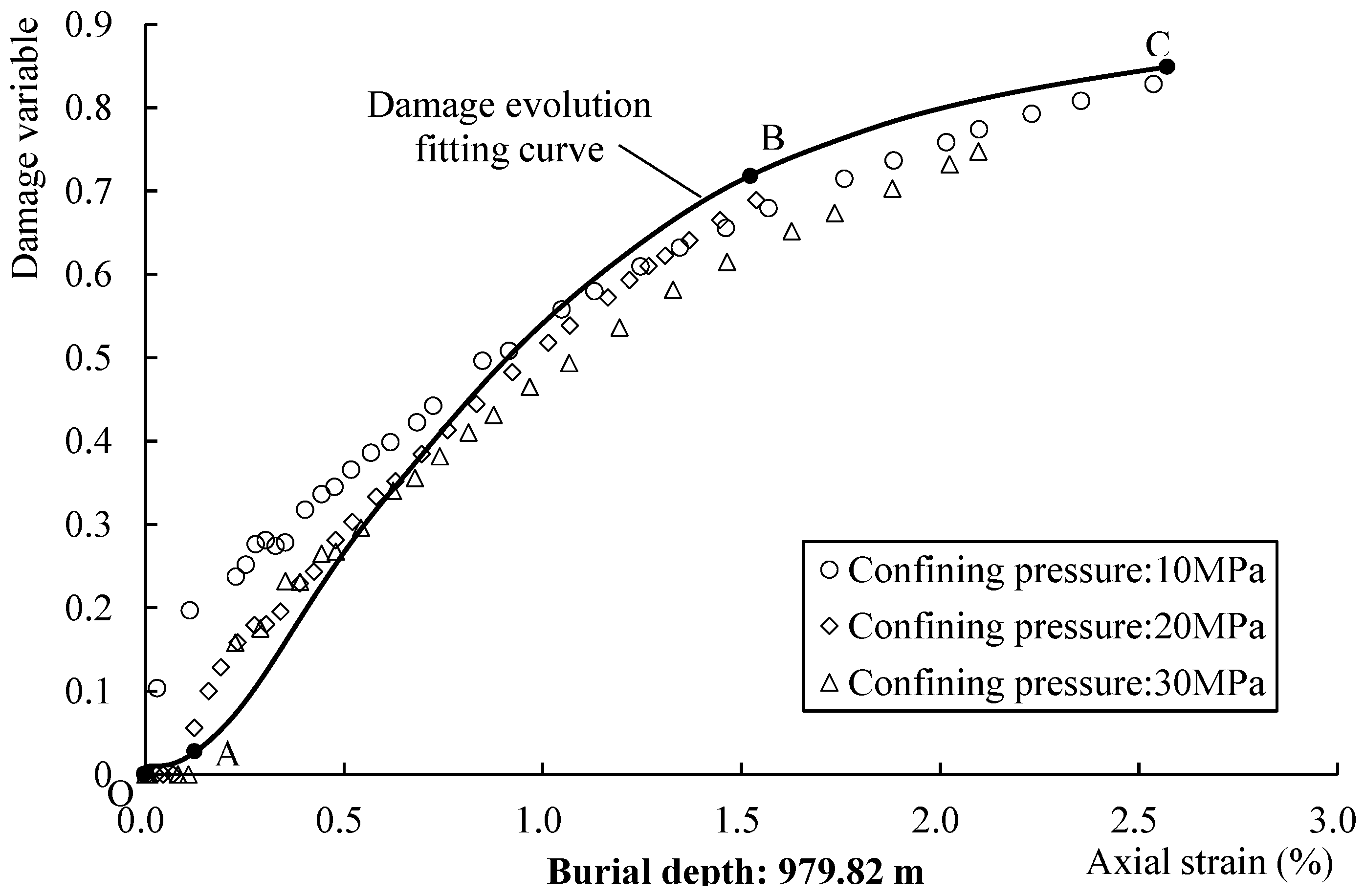

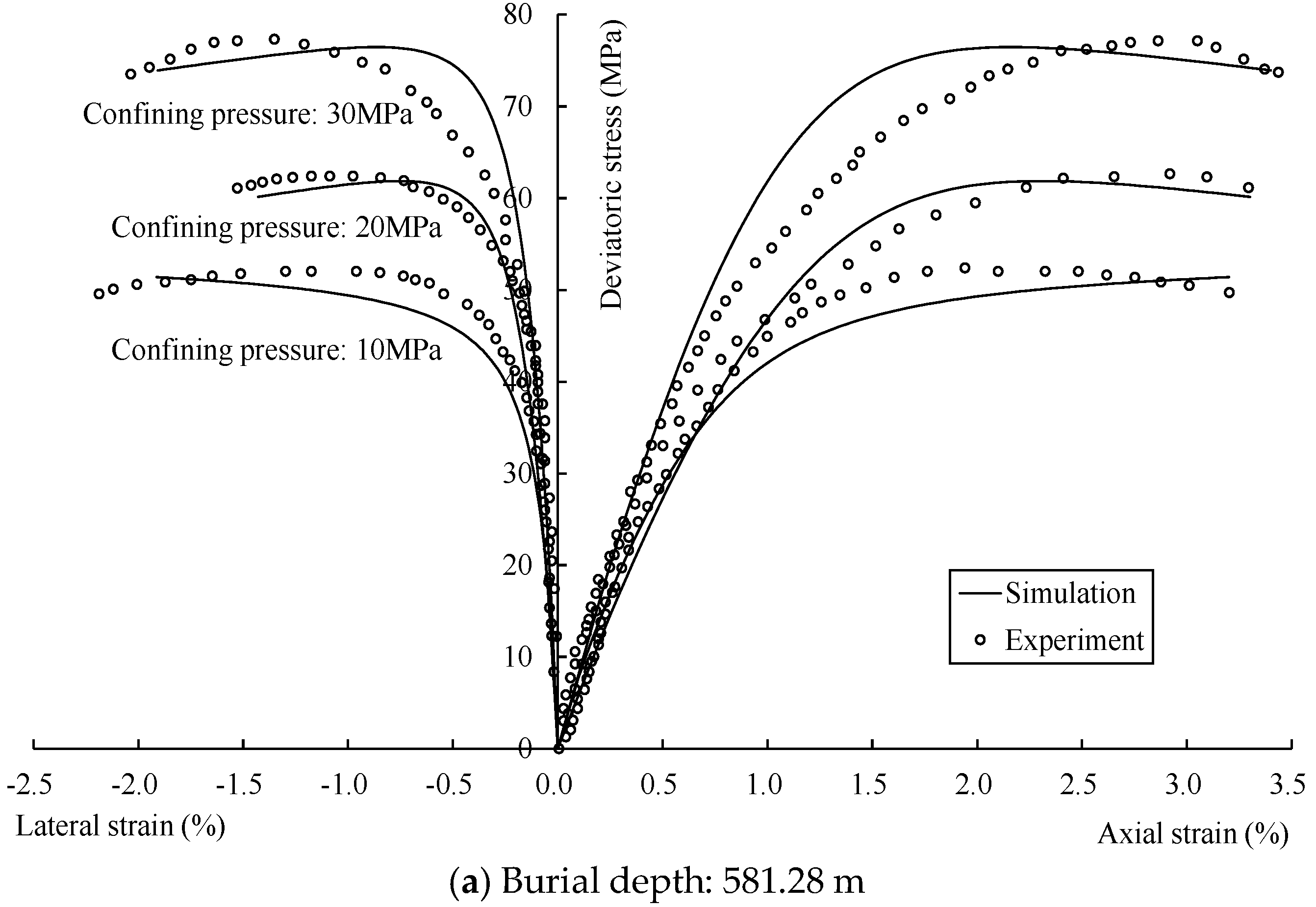
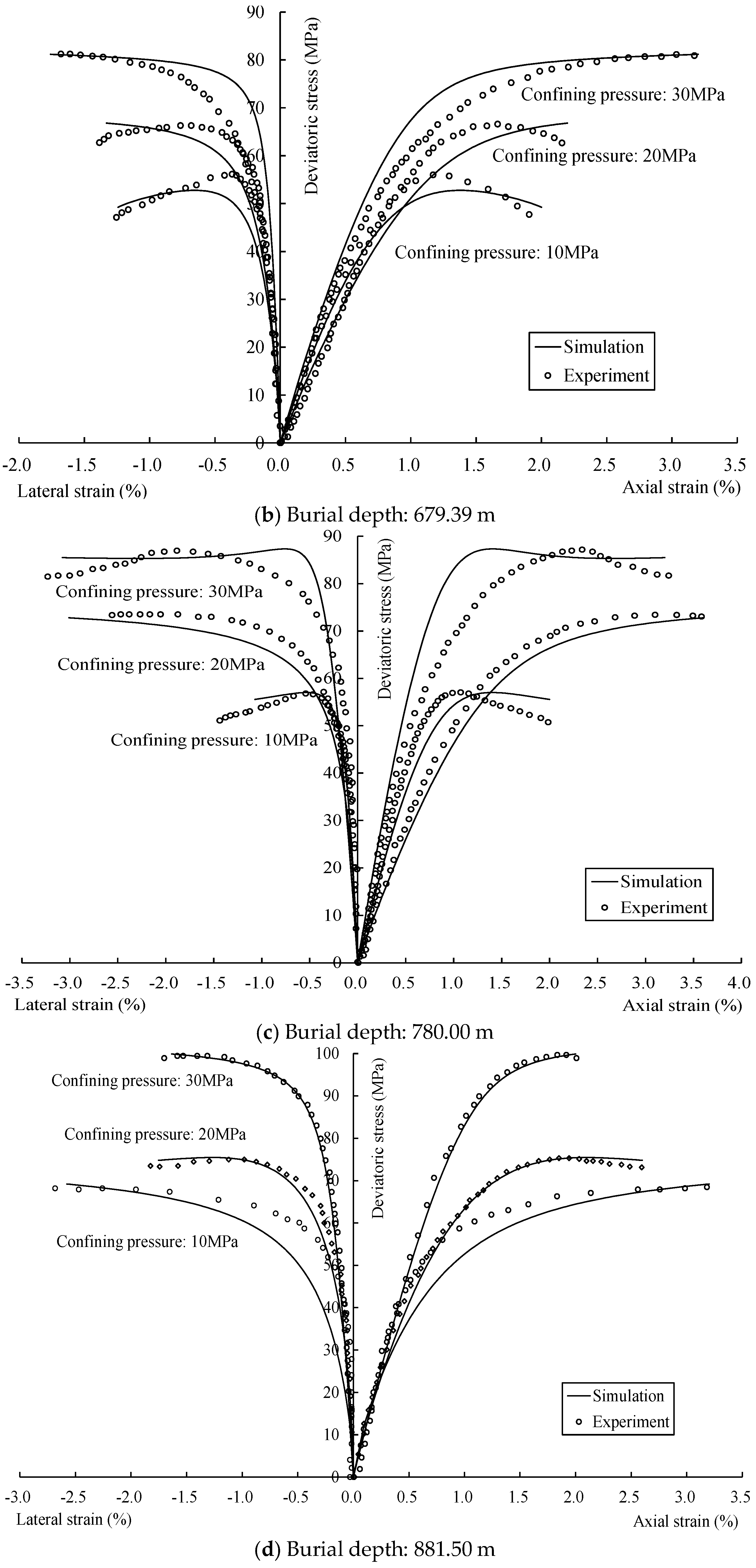
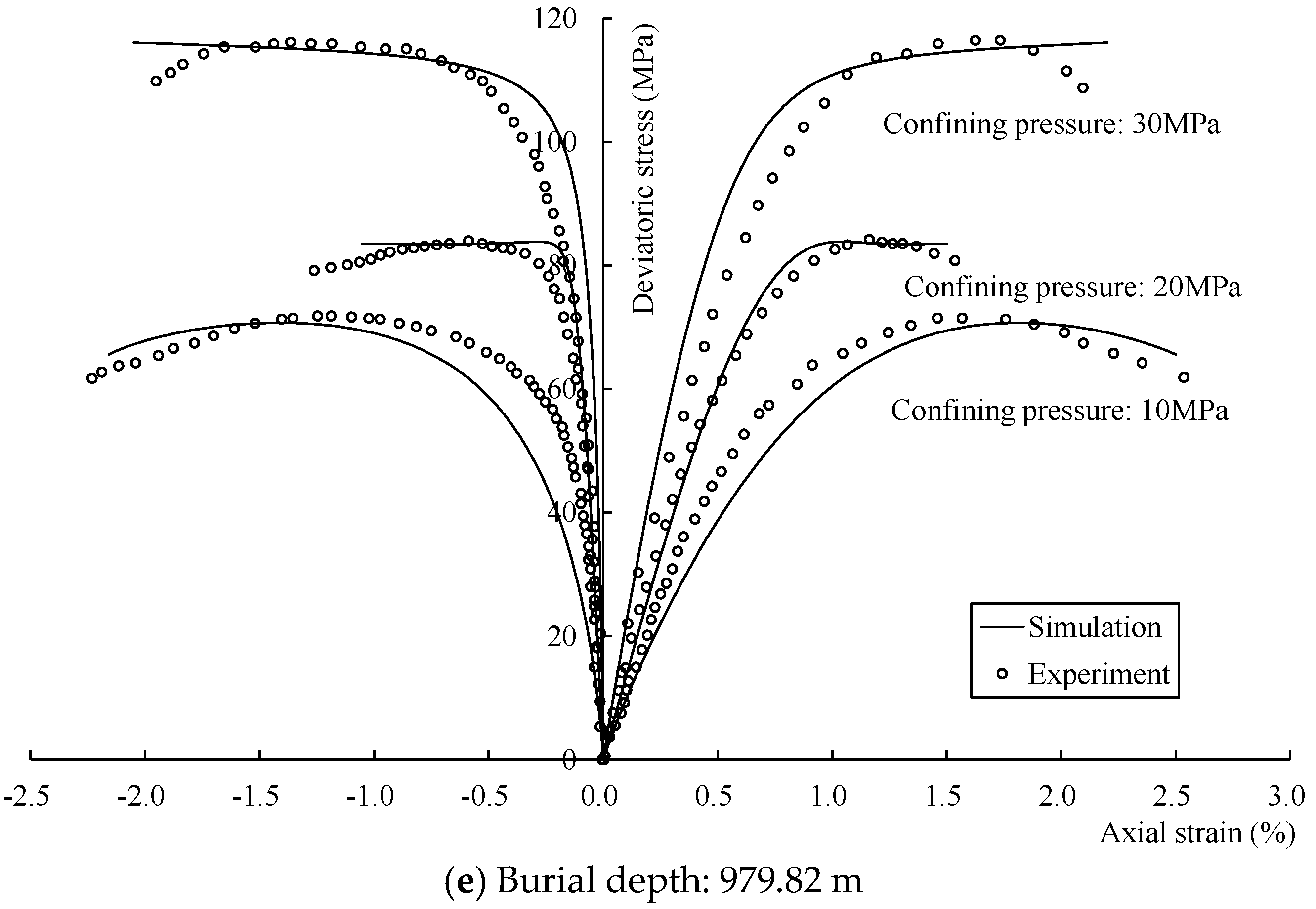
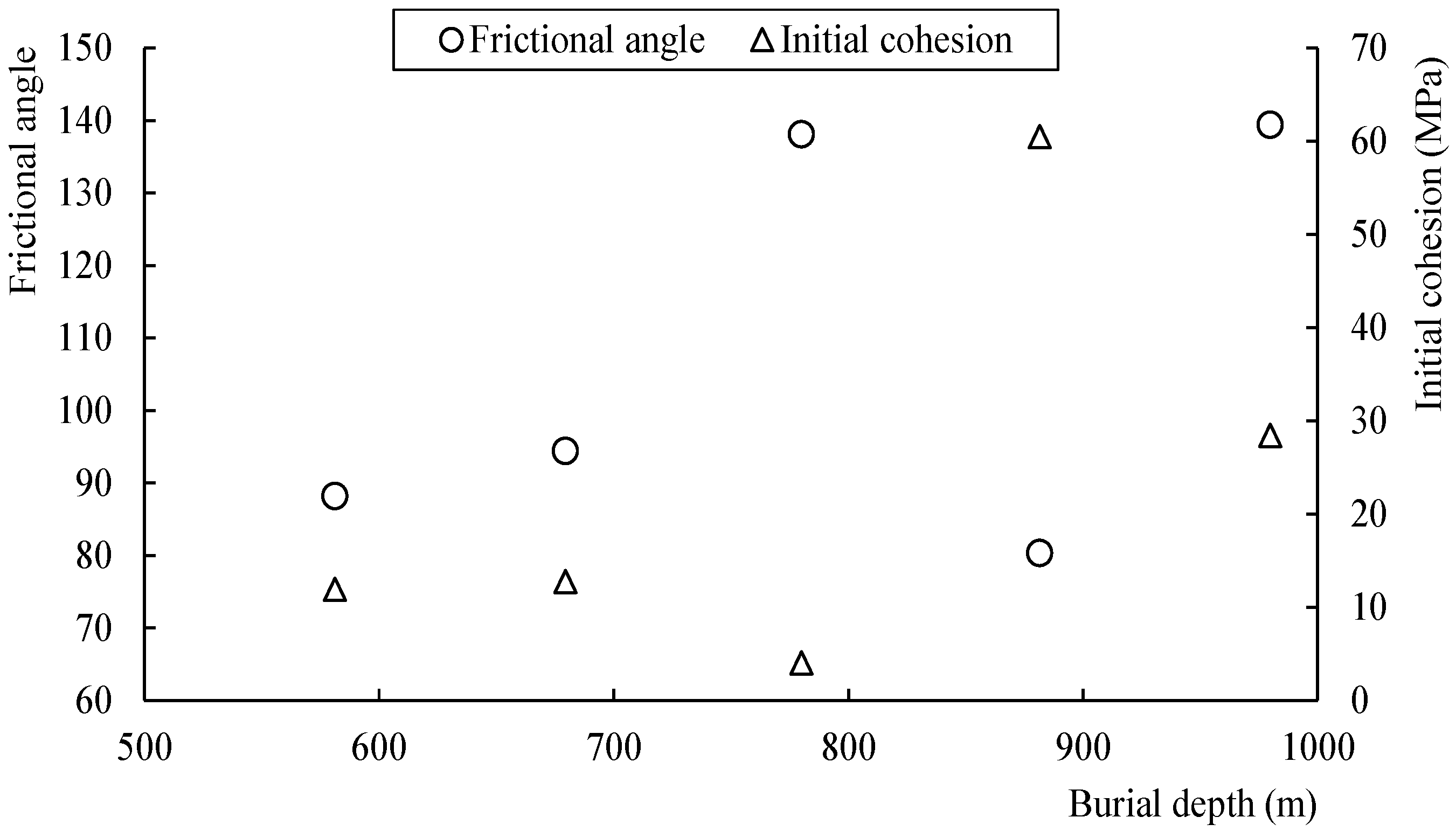
| Burial Depth/m | |||||||||
|---|---|---|---|---|---|---|---|---|---|
| 581.28 | 7.34 | 0.094 | 88.17 | 11.915 | 0.0039 | 0.002 | −0.013 | 0.75 | 0.9 |
| 679.39 | 7.98 | 0.140 | 94.39 | 12.736 | 0.0054 | 0.001 | −0.014 | ||
| 780.00 | 8.74 | 0.093 | 138.10 | 4.020 | 0.0055 | 0.003 | −0.009 | ||
| 881.50 | 11.66 | 0.150 | 80.31 | 60.471 | 0.0052 | 0.005 | −0.012 | ||
| 979.82 | 15.91 | 0.142 | 139.38 | 28.439 | 0.0023 | 0.005 | −0.007 |
© 2020 by the authors. Licensee MDPI, Basel, Switzerland. This article is an open access article distributed under the terms and conditions of the Creative Commons Attribution (CC BY) license (http://creativecommons.org/licenses/by/4.0/).
Share and Cite
Zhang, Y.; Wang, L.; Zi, G.; Zhang, Y. Mechanical Behavior of Coupled Elastoplastic Damage of Clastic Sandstone of Different Burial Depths. Energies 2020, 13, 1640. https://doi.org/10.3390/en13071640
Zhang Y, Wang L, Zi G, Zhang Y. Mechanical Behavior of Coupled Elastoplastic Damage of Clastic Sandstone of Different Burial Depths. Energies. 2020; 13(7):1640. https://doi.org/10.3390/en13071640
Chicago/Turabian StyleZhang, Yu, Lu Wang, Goangseup Zi, and Yan Zhang. 2020. "Mechanical Behavior of Coupled Elastoplastic Damage of Clastic Sandstone of Different Burial Depths" Energies 13, no. 7: 1640. https://doi.org/10.3390/en13071640
APA StyleZhang, Y., Wang, L., Zi, G., & Zhang, Y. (2020). Mechanical Behavior of Coupled Elastoplastic Damage of Clastic Sandstone of Different Burial Depths. Energies, 13(7), 1640. https://doi.org/10.3390/en13071640





